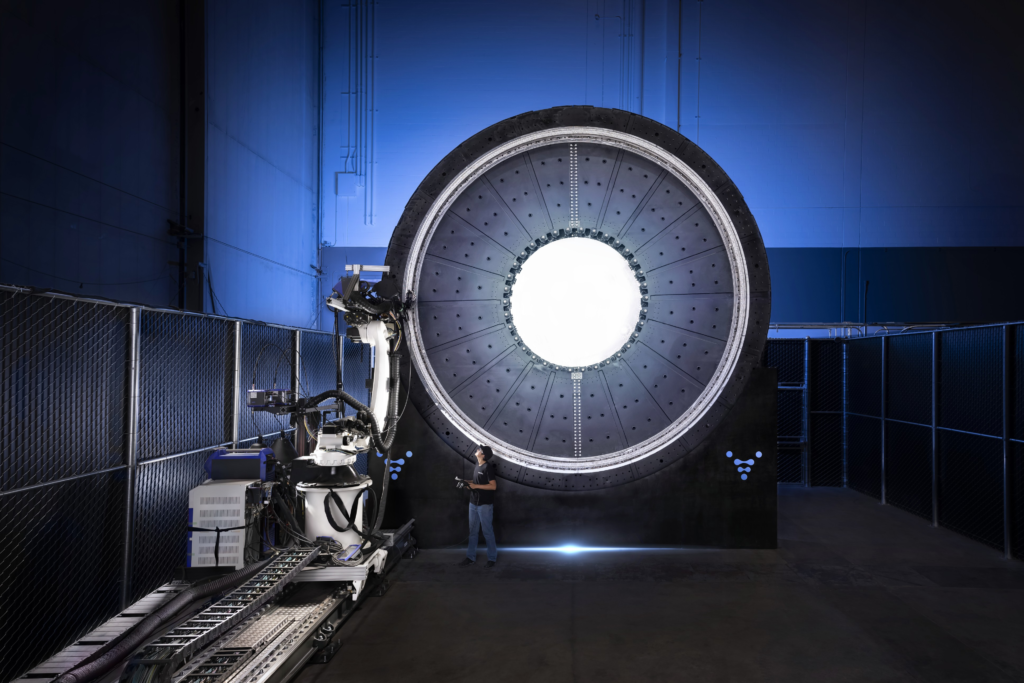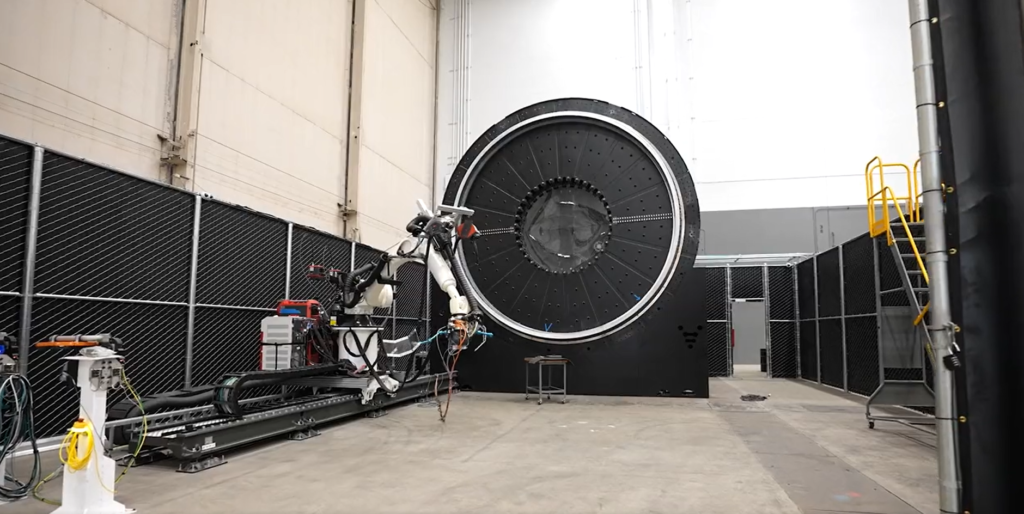
Relativity Space Just Revealed Its 4th Generation Stargate Printer
Relativity Space is a company with no shortage of ambitious future goals. Between work on Terran 1, a fully reusable Terran R, future missions to Mars, and more, the company is trying to achieve many firsts. One of the most notable is the process of 3D printing entire launch vehicles using a completely unique manufacturing process.
With this abnormal approach comes the need for equally unique tooling and machines responsible for the job. Just yesterday the company revealed the next best equipment for this exact task in the form of a next generation 3D printer. Specifically, the company announced the 4th Generation Stargrade metal 3D printer. Some of its features include increased size, strength, speed, and more.
Developed in-house, horizontal printing, ramping up the development and rate production of Terran R. Another big step for Relativity Space as they get closer to the first launch of Terran 1, and some critical development of its bigger brother Terran R. Here I will go more in-depth into this new 3D printer, its improvements from past models, what to expect in the near future, and more.
New Stargate Printer

In just the last few weeks Relativity Space has been announcing a bunch of new information and general updates. Yesterday was no exception when the company tweeted saying, “Surprise! Meet our newest Stargate 4th Generation metal 3D printers. Bigger. Faster. Stronger. Developed in-house. Horizontal printing, ramping up the development and rate production of Terran R. *Human for scale*” This included two different images of the new massive 3D printer inside Relativity’s massive facility named the Wormhole. Specfically, on October 24th Relativity unveiled the latest iteration of its first-of-its-kind proprietary manufacturing platform, Stargate 4th Generation metal 3D printers. These printers will underpin both the development and rate production of Terran R, Relativity’s fully reusable, 3D printed rocket that will be capable of launching 20,000 kg to low Earth orbit (LEO).
The company highlighted that the newest Stargate printer technology defies traditional printing constraints by moving horizontally as it feeds multiple wires into a single print head to print orbital rockets. Relativity is developing customized software and machine learning techniques to allow these printers to print more complex and significantly larger metal products, with improved print speed and reliability. Stargate 4th Generation printers also radically simplify manufacturing supply chains, as they are capable of printing a rocket with 100x fewer parts in a matter of months. With faster iteration cycles, Stargate printers are capable of accelerating progress and innovation within the aerospace industry. Most immediately, Stargate 4th Generation printers will serve as the primary manufacturing infrastructure for Terran R production. Longer-term, Stargate 4th Generation printers are expected to offer tremendous value-generating potential for other end-product use cases within the $1T+ aerospace, aviation, energy, and defense industries as the core of a new tech stack for aerospace products. To date, Relativity has secured five customers across $1.2B+ in customer contracts for Terran R, including a multi-launch agreement with OneWeb and a commercial mission to Mars with Impulse Space.
During the announcement, CEO of Relativity Tim Ellis said, “Large-scale products that are designed to fly will inevitably be 3D printed. The lighter a product is, the better it performs, and when 3D printing that product, it’s also faster and more cost-effective to produce with each successive improvement. The compounding rate of progress is high, and we are still in the early days of what printing can achieve. We see 3D printing as an automation technology that has the power to change the pace of innovation in manufacturing, which is why we’ve invested in building our own proprietary tech stack from day one. Stargate printers are designed to unlock rapid iteration, which opens up opportunities for innovation in large-scale manufacturing products. What would take traditional aerospace and space manufacturers years to develop and build, will be reduced down to months due to a highly adaptable, scalable, and automated process, made possible through software-driven manufacturing.”
New Printer Improvements

Now that we know a bit more about yesterday’s big reveal, we can take a closer look at some of the main improvements provided by this new generation of 3D printers. Starting with improvements in print speed. To put it in perspective, 1st, 2nd, and 3rd Generation Stargate printers already operate at print speeds well beyond industry standards. 4th Generation Stargate printers improve on their predecessors and offer 7x faster than earlier generation Stargate printers and even achieve up to 12x faster printing over Relativity’s already industry-leading performance. The next benefit has to do with print orientation and environment. The new printers facilitate increased print size capacity through the use of a horizontal print orientation. Stargate 4th generation printers remove ceiling height constraints which impact vertical 3D printers. Through horizontal printing, these printers are capable of printing objects up to 120 feet long and 24 feet wide, resulting in an increased volume capacity of 55x its 3rd generation predecessor.
In addition, a reduced print start time and cost is supported by an integrated approach to build setup and print plate preparation. Not to mention, it features reduced entropy, for more consistent, reliable manufacturing than can be realized through a configuration which centralizes work centered around Stargate’s robotic automation platform. Also, improved print quality and work center efficiency is achieved through powerful perception technology for in-process monitoring, which fuses together computer vision, advanced sensors, and real-time telemetry. Lastly, lighter, more cost-effective aerospace product production through rapid iteration is generated by leveraging Stargate printers and material science advancements developed in Relativity’s in-house metallurgical laboratory. Relativity has proprietary, high-performance next generation materials which will be used for products printed with Stargate 4th Generation printers. Most immediately, Terran R will be the first product in a series of products to benefit from the use of lighter materials and a faster production time, creating significant cost reductions for customers downstream. All of which combine to create the company’s next generation of 3D printers and the future of Terran R.
Focusing back on yesterday’s reveal, Relativity’s SVP of Software Engineering highlighted, “Iteration empowers innovation not only in our rocket design, but also in our own Stargate printers. In its short history, Relativity has made great strides in evolving its core 3D printing technology, but Stargate 4th Generation printers are our most innovative leap yet. We’re fundamentally changing the way our factories are designed and operating, and by flipping the script and going horizontal, we’re radically increasing our capacity for scale. Being a software-driven manufacturing company allows us to achieve unique product features, such as integrated pad-ups and domes, with radical flexibility.”
The majority of Terran R components will be printed inside Relativity’s new 1 million + square foot headquarters in Long Beach, named The Wormhole. Aeon R engines, for Terran R, will continue to be produced at the company’s other Long Beach factory, The Portal. The Wormhole, a former Boeing C-17 manufacturing plant, was secured by Relativity to be its new headquarters in 2021. Currently 33% operational, the factory has several Stargate 4th Generation printers online with more than a dozen printers planned to be producing Terran R components in the coming months. At the full capacity forecasted run rate, each Stargate 4th Generation printer is capable of producing 4 Terran R rockets per year. The remainder of the Wormhole will continue to be built out in phases, bringing more printers online and moving more teams into the company’s headquarters as production for Terran R scales.
As you can imagine, this is all very big news from Relativity. In only a few weeks the company has revealed testing on the Aeon R engines, an expansion at NASA Stennis for Terran R testing, and the next gen of 3D printers already in operation. All of which working toward the goal of reinventing the rocket manufacturing process. As the company often highlights, for over half a century, aerospace manufacturing has relied on large factories, fixed tooling, complex supply chains, and extensive manual labor to build costly rockets comprised of 100,000+ parts in 2 years or longer. In order to accelerate innovation in the industry, Relativity built its Factory of the Future, the first aerospace platform to automate rocket manufacturing, vertically integrating intelligent robotics, software, and data-driven 3D printing technology. Incorporating multiple generations of Stargate, the world’s largest metal 3D printers with AI-driven controls, resulting in greatly compounded quality and time improvements, lower costs, and product designs previously not possible.
Conclusion
Relativity Space just announced some very significant news with the reveal of its 4th generation Stargate printers. These massive machines will print horizontally and feature a host of unique benefits from past generations. An exciting technology that is expected to be applied to Terran R in a short period of time. We will have to wait and see how it progresses and the impact it has on the space industry.
